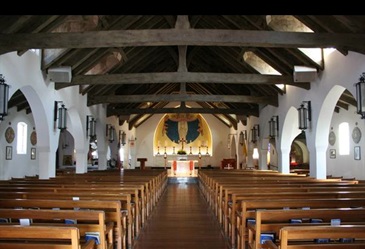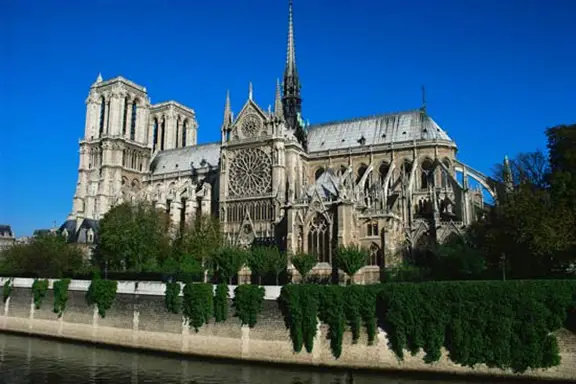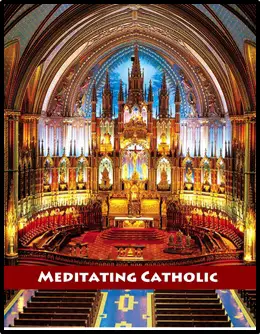|
TRANSLATE THIS ARTICLE
Integral World: Exploring Theories of Everything
An independent forum for a critical discussion of the integral philosophy of Ken Wilber
 David Christopher Lane David Christopher Lane, Ph.D.
Professor of Philosophy, Mt. San Antonio College Lecturer in Religious Studies, California State University, Long Beach Author of Exposing Cults: When the Skeptical Mind Confronts the Mystical (New York and London: Garland Publishers, 1994) and The Radhasoami Tradition: A Critical History of Guru Succession (New York and London: Garland Publishers, 1992). SEE MORE ESSAYS WRITTEN BY DAVID LANE
Meditating Catholic
An Agnostic Pilgrimage For Contemplative
Enclaves Inside Roman Catholic Churches
David Lane
It might seem odd that a skeptic like myself would find refuge in such God-believing places.
Although I have prayed in Catholic churches from the age of three or four, it was not until I was eleven or twelve that I took up meditating in them. St. Charles in North Hollywood (now Valley Village) was the church of my childhood and I think it was fraught with too many bad memories of nuns, priests, confessions, and long penances, to kindle my spiritual inclinations. Other enclaves, devoid of any familial connections, provided me with more inspiration.
When I was twenty years old, an older friend of mine (in his mid-60s), Johnny Haddad, and I decided to visit the New Camaldoli Hermitage in Big Sur. We planned on staying for a week in our cloistered cells doing meditation and reading sacred literature. It was a frustrating trip for me, since as we were driving up the coast I could see that a large and newly arriving swell was hitting the Pacific coast. As a surfer, I was aching to catch some of the big waves, but I knew that I had already committed to stay at the Catholic retreat.
The monks assigned us each a private room adjacent to each other. Our daily food and drink would arrive through a sliding door and we would essentially have no contact, outside of Vespers and early morning Mass. At first we enjoyed the solitude and the quiet time, but after a few days (and hearing the pounding surf) I was I getting anxious to leave. But I felt that Johnny was in for the long haul so I didn't want to hurry him. Yet, much to my pleasant surprise, Johnny knocked on my wall and in a plaintive yelp cried out, “I am bored stiff; let's get the hell out of here!”
Being slightly embarrassed by our lack of fortitude, we came up with some lame excuse about a family emergency and we hastily drove out of the hermitage laughing at how feeble our hermit like attempt had been. I think we both liked the “idea” of being a monk more than actually practicing being one.
Yet, I do think this brief encounter with private holiness did influence me as I began to seek out varying Catholic churches whenever I wanted to get a bit of alone time. When I started teaching Christology and Moral Theology at Moreau Catholic High School in Hayward, California in 1979, I was happy to discover that there was a chapel on the 2nd floor. Invariably during lunchtime I would sneak off for forty minutes or so and blissfully meditate before my next class started. I was bummed the following year when due to the Holy Cross' remodeling plans the chapel was shut down.
The next two Catholic high schools that I taught at (Chaminade College Prep and the University of San Diego High School) had chapels but they were busy affairs and it was difficult to meditate in either alone. However, I did notice that the University of San Diego, which was right across the street, had a magnificent Church which was surprisingly empty most of the time and quite conducive for meditating or praying. I used to visit it after browsing the USD library.
There were also several other temples that caught my attention around this time as well, including the Self-Realization Fellowship's meditative enclave in Encinitas and, perhaps most impressive of all, the Vedanta Temple in Hollywood which was right next to the 101 freeway, but which was eerily still and peaceful.
My fondness for Catholic churches as meditative escapes became renewed this last year when I discovered a stunning Catholic Church dedicated to St. Francis of Assisi, just blocks away from our desert home in La Quinta, California. What most impressed me about this particular church, besides the dramatic mountain directly behind it, was the austere simplicity of its architecture. The only drawback is that the Church is not always open so one has to be lucky in timing one's visits accordingly.
Because of the wonderful setting and experiences I have had in the St. Francis of Assisi Catholic Church in the desert, I have begun an informal quest to consciously seek out similar places for quiet meditation. So far this past month I have come upon two more contemplative retreats. The first one I came upon by chance as I was on a surf trip with my family in La Jolla Shores. After I visited one of my all-time favorite bookstores, D.G. Wills, I ended up taking a wrong turn and ended up on Girard Street only to come upon an exquisite Catholic Church right in the middle of the shopping district, appropriately named Mary Star of the Sea. This quaint and very airy church, with its wafts of fresh ocean air circulating throughout, has an old California charm to it. The only drawback is that it can be a bit noisy due to its bustling location, but even that is mitigated by its delightful ambiance. The wooden floors and benches give it a charm often missing in newer churches.

My most recent pilgrimage is closer to my home in Huntington Beach. Just off of Talbert Street, right next to a cemetery, stands a stunning Catholic Church called St, Vincent De Paul, which represents an almost “post” modern version of a cathedral. Disorienting at first, since the altar is literally surrounded by three sides, the church is remarkably open and spacious. I was most impressed by the fact that the church was open every day until 8:30 at night. Interestingly, and not without irony, I always avoid Catholic Churches whenever there is a mass or some other ceremony which draws a crowd. In his regard, I only like going to these places of worship when there is almost nobody there worshipping. It is when such churches are almost vacant that I find them the most alluring.
It might seem odd that a skeptic like myself who more or less despises much of Catholic theology and much of its sordid past, would find refuge in such God-believing places. But I think even the most ardent of atheists can find solace in religious centers primarily because they represent focal places of human longing, regardless of whether one accepts the metaphysical theologies that underpin their existence.
Catholic churches, like Jewish synagogues or Hindu temples, are in general places where human beings gather to pour out their deepest yearnings and longings. And, within this context, represent some of the noblest ideals of what it means to be a vulnerable human being. If one can look past the theological trappings that seem endemic to such sacred houses, then one can tap into a fulcrum of genuinely heartfelt emotion. Seen from this perspective, it could perhaps be argued that religious centers of varying kinds are indeed sacred centers for human beings, even if one enters such abodes devoid of any supernatural belief.
Here is my little checklist of what I look for in my pursuit of “meditating” Catholic, even in the midst of eschewing a specific Christian belief system.
- The church should be empty or close to empty. Practically speaking, I have found mid-morning or mid-afternoon to be the best time to find the fewest attendees.
- Niches within the church. I personally like when the particular church has smaller enclaves within it. For example, side seats devoted to various saints or to the Virgin Mary or Joseph.
- Open door policy. It is disconcerting to go to a Catholic church only to find that it is closed most of the time or only open Sundays or for special events.
- Aesthetic appeal. The architectural beauty of a church is an essential key. I remember back in the late 1970s hearing Professor Jacob Needleman going on and on about how beautiful Notre Dame Cathedral was in Paris, France. I thought he was exaggerating until I actually visited it several times in the 1990s. It was breathtaking and I can imagine even Richard Dawkins genuflecting when taking in its beauty.

|
 David Christopher Lane, Ph.D.
Professor of Philosophy, Mt. San Antonio College Lecturer in Religious Studies, California State University, Long Beach Author of Exposing Cults: When the Skeptical Mind Confronts the Mystical (New York and London: Garland Publishers, 1994) and The Radhasoami Tradition: A Critical History of Guru Succession (New York and London: Garland Publishers, 1992).
David Christopher Lane, Ph.D.
Professor of Philosophy, Mt. San Antonio College Lecturer in Religious Studies, California State University, Long Beach Author of Exposing Cults: When the Skeptical Mind Confronts the Mystical (New York and London: Garland Publishers, 1994) and The Radhasoami Tradition: A Critical History of Guru Succession (New York and London: Garland Publishers, 1992).

